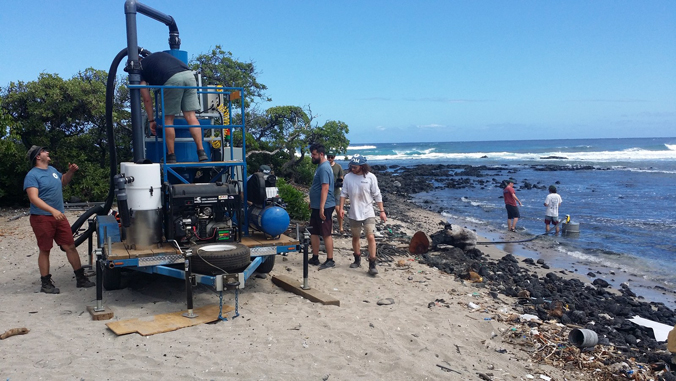
A machine built to filter microplastics from the sand on one of Hawaiʻi’s dirtiest beaches has been delivered to Hawaiʻi Island, kicking off a collaboration between the University of Hawaiʻi at Hilo, the Hawaiʻi Wildlife Fund and engineering students from the Université de Sherbrooke in Québec, Canada.
The machine, named Hoʻola One (“bring life back to the sands” in Hawaiian), is designed to filter out microplastics (small plastic fragments less than five millimeters long) while allowing natural sand and rocks to pass through.
“I think these really small pieces of plastic that have accumulated on our beaches are a problem for the environment,” said Steven Colbert, UH Hilo associate professor of marine science. “Removing those from the sediments is definitely an important part of the process of returning these coastal habitats back to a more pristine state.”
Nicolas Vanderzyl, a UH Hilo senior in the marine science department, is working with the Hawaiʻi Wildlife Fund to measure how effective Hoʻola One is at removing the microplastics from sediments at Kamilo Point, by comparing the sediments before and after the filtering.
Hawaiʻi Island’s Kamilo Point, which is known for its accumulation of garbage and marine debris from the Great Pacific Garbage Patch, is known as “junk beach,” a reference to the thousands of pieces of plastic that wash up on its shores. The Hawaiʻi Wildlife Fund has removed more than 268 tons of marine debris from this part of the island since 2003.
Hoʻola One was designed and built by a team of 12 engineering students at the Université de Sherbrooke in Québec.
“It’s basically a big vacuum cleaner that someone operates,” said Alexandre Savard, who leads the team of students. “We vacuum everything into an empty reservoir, and once the reservoir is full, a six-inch valve opens and drops everything down into a decanter, which is full of seawater. After decantation the plastic floats on the top while the sand and rocks sink to the bottom. The plastic is filtered from the water with stainless steel filters and the sand and rocks are returned straight to the beach.”
Once Savard and his team had a viable prototype of the machine in Québec, they contacted Hawaiʻi Wildlife Fund to ask if they could test the machine at Kamilo Point.
“They had a two-year project and had heard about Kamilo Point, and wanted to do something about plastic pollution and microplastics,” said Megan Lamson, marine scientist and president of Hawaiʻi Wildlife Fund. “It’s a huge issue and nobody has found a successful way to clean up the debris. We’ve tried everything from sifting trays to flotation, and we really hope this works, because it’s going to be a lot more efficient.”
Read the full story at UH Hilo Stories.
–Written by Leah Sherwood, a graduate student in the tropical conservation biology and environmental science program at UH Hilo.

